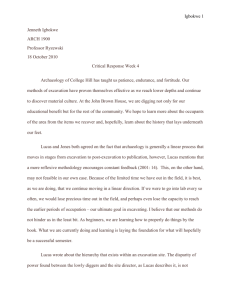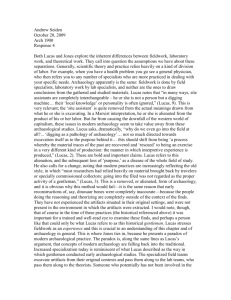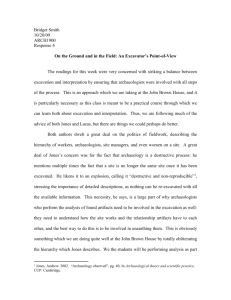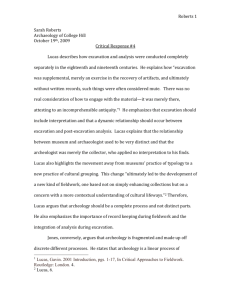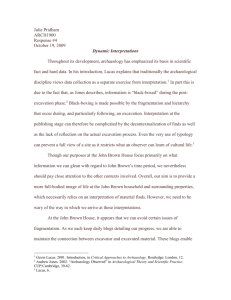ARCH1900.RP4.Merchant
advertisement
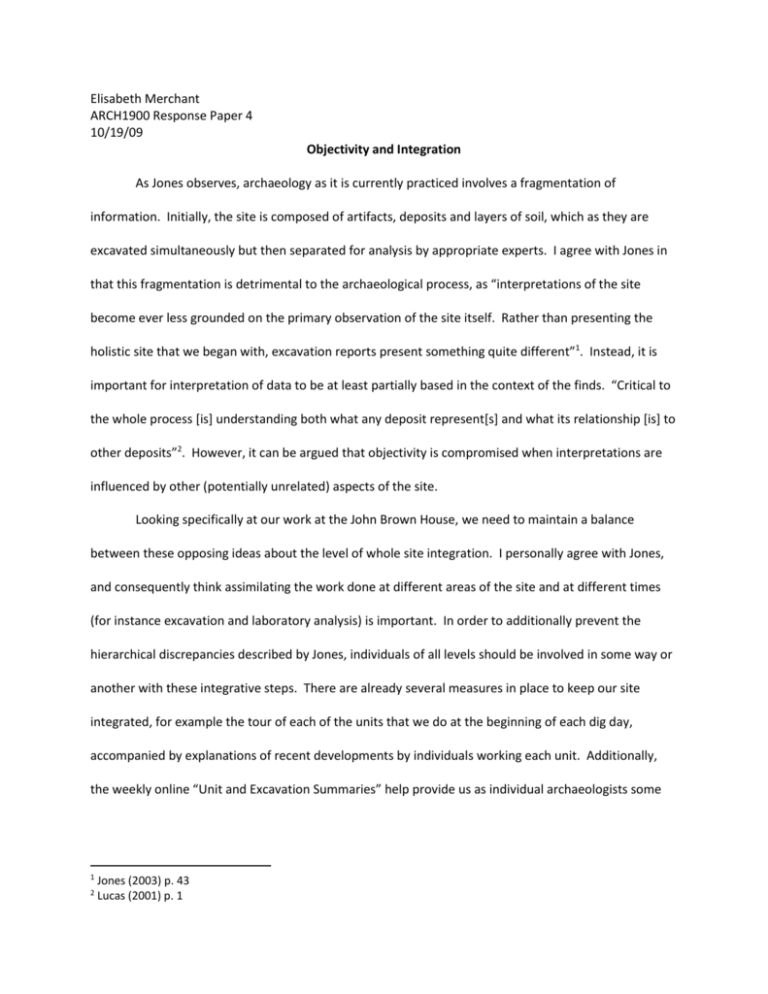
Elisabeth Merchant ARCH1900 Response Paper 4 10/19/09 Objectivity and Integration As Jones observes, archaeology as it is currently practiced involves a fragmentation of information. Initially, the site is composed of artifacts, deposits and layers of soil, which as they are excavated simultaneously but then separated for analysis by appropriate experts. I agree with Jones in that this fragmentation is detrimental to the archaeological process, as “interpretations of the site become ever less grounded on the primary observation of the site itself. Rather than presenting the holistic site that we began with, excavation reports present something quite different”1. Instead, it is important for interpretation of data to be at least partially based in the context of the finds. “Critical to the whole process [is] understanding both what any deposit represent[s] and what its relationship [is] to other deposits”2. However, it can be argued that objectivity is compromised when interpretations are influenced by other (potentially unrelated) aspects of the site. Looking specifically at our work at the John Brown House, we need to maintain a balance between these opposing ideas about the level of whole site integration. I personally agree with Jones, and consequently think assimilating the work done at different areas of the site and at different times (for instance excavation and laboratory analysis) is important. In order to additionally prevent the hierarchical discrepancies described by Jones, individuals of all levels should be involved in some way or another with these integrative steps. There are already several measures in place to keep our site integrated, for example the tour of each of the units that we do at the beginning of each dig day, accompanied by explanations of recent developments by individuals working each unit. Additionally, the weekly online “Unit and Excavation Summaries” help provide us as individual archaeologists some 1 2 Jones (2003) p. 43 Lucas (2001) p. 1 knowledge of what is transpiring outside of our direct realm of work which might influence our archaeology. In terms of creating temporal integration of the various steps of the archaeological process, I think it would be helpful for us to keep a written record of the possible interpretations that we have for our data as we proceed with the digging and later with the analysis. However, it would be important to maintain a separation between fact and interpretation. Failing to do so could become problematic, as Lucas illustrates, “a contradiction [existed] within British fieldwork in that it recognizes there is interpretation prior to, or embedded in, the process of excavation and yet in practice it continues to pretend that this primary data collection was prior to interpretation; that description can be separated from interpretation”3. This could be avoided by recording basic, factual descriptions (for example, shapes and colors of artifacts) separately from any interpretations (for example the nature or use of an artifact). This process of integrating data while maintaining objectivity should extend to laboratory work as well. For instance, the “black boxing” of information described by Jones be avoided; even at the analysis level blurring the distinction between fact and interpretation should be avoided, and the option of obtaining a second opinion on an interpretation should be maintained. Jones emphasizes that “often the post-excavation specialist is in possession of little or no information concerning the context or nature of the feature from which the material they are analyzing was obtained”4. Whiles this does provide a “form of independent process against which the material and the site are tested”4, when data is analyzed ‘blind’ of the context of the site, the initial analysis should not be absolute, but instead should be provisional and weighted against the context of the find to determine a final interpretation. It is important for us to maintain a balance between integration and objectivity as we continue our archaeological analysis of the grounds of the John Brown House. Our goals are to obtain more 3 4 Lucas (2001) p. 14 Jones (2003) p. 47 information about the house throughout its historical evolution. As such, our finds will be interpreted and assigned to one of the different time periods of the house. As we dig, we need to keep each other informed of the work that is going on at our individual units, as well as our preliminary interpretations of those findings while carefully maintaining a differentiation between fact and interpretation. Additionally, we need to integrate the work we do at different stages of the process. The initial interpretations made in the field should be considered when we are in the lab, although not relied upon. When data can be obtained ‘blind’ of the context, it is appropriate to do so as a scientific ‘check’, but this data should still not be taken as fact until some sort of interpretative agreement between it and the context can be reached. Ultimately, “object and context are not independent and should not be treated as if they were”5, although objectivity should be maintained by differentiating between fact and interpretation, and re-analyzing when necessary, at every step during the archaeological process. Jones, Andrew. 2002 Archaeology observed, pgs. 39-62, In Archaeological theory and scientific practice. CUP: Cambridge. Lucas, Gavin. 2001 Introduction, pgs. 1-17, In Critical Approaches to Fieldwork. Routledge: London. 5 Lucas (2001) p. 14
